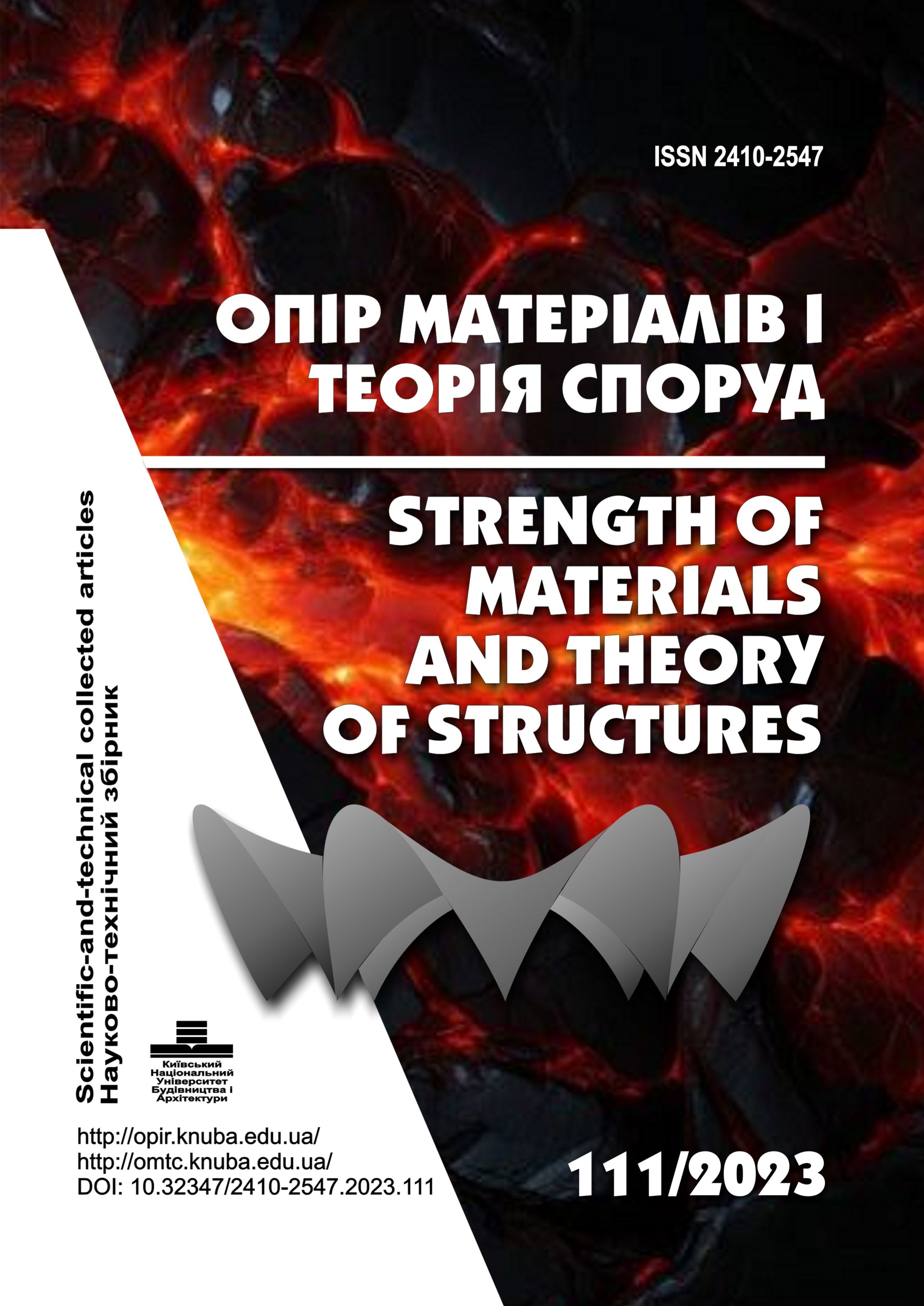Computer modelling of thin-walled shell structures with geometric imperfections
DOI:
https://doi.org/10.32347/2410-2547.2023.111.205-213Keywords:
modelling, shell, imperfection, buckling, radial pressure, finite element, nonlinear analysis, ANSYSAbstract
The study presented in the article focuses on modelling of thin-walled cylindrical shell structures with initial geometrical imperfections under external radial pressure. The critical pressure of the perfect shell obtained using linear analysis significantly exceeded that calculated by the Papkovich formula. This discrepancy can be attributed to the shell displacement constraints and the fact that linear analysis provides non-conservative estimates. Initially, the geometric imperfections were assumed to follow an eigenmode-affine pattern with varying amplitudes. Critical pressure values iteratively determined using the modified Ricks method were found to be lower than the critical pressure of the first buckling mode. Importantly, all these values remained notably higher than the normative value. Subsequently, the initial imperfections were modelled as combinations of sinusoidal deviations with different amplitudes and varying numbers of waves along the perimeter. Short-wavelength eigenmode-affine imperfections were superimposed on longer-wavelength deviations. The research indicated that while the long-wavelength imperfections had a marginal impact on the critical pressure values, they notably altered the post-buckling behaviour of the shell, as depicted in load-deflection figures in the form of loops. These processes occurred at pressure levels considerably higher than the normative value. The simulation results are in good agreement with established theories regarding the pre- and post-buckling behaviour of thin-walled shells. Nonlinear analysis revealed that the actual critical pressure values exceeded the normative value by 30-45%, and the post-buckling pressure values exhibited a gradual decrease without posing a threat to abrupt changes in the geometry of the shells. This outcome provides a basis for a more accurate estimation of the load-carrying capacity of the shell structures.
References
Timoshenko S., Woinowsky-Kreiger S. Theory of plates and shells. New York: McGraw-Hill Book Company, Inc. - 1959.
Timoshenko S., Gere J. Theory of elastic stability. New York: McGraw-Hill Book Company, Inc. - 1961.
Alfutov N.A.Osnovy rascheta na ustoichivost upruhikh system. (Fundamentals of elastic systems stability calculating). Moscow: Mashinostroenie. - 1961.
Kolkunov N.V. Osnovy rascheta upruhikh obolochek. (Fundamentals of elastic shells calculation). Moscow: Vysshaja shkola. - 1972.
Yegorov Y., Kucherenko O., Repryntsev O. Finite element modelling of the contact between shell structure and foundation // Strength of Materials and Theory of Structures: Scientific-and-technical collected articles. – K.: KNUBA. - 2023. – Issue 110. – P. 421-429.
Calladine C. Understanding imperfection-sensitivity in the buckling of thin-walled shells // Thin-Walled Structures. – 1995. – Vol. 23. – Issue 1. - P. 215–235.
Bazhenov V.А., Luk’yanchenko О.О., Kostina О.О., Gerashchenko О.V. Probabilistic Approach to Determination of Reliability of an Imperfect Supporting Shell // Strength of Materials. – 2014. - Vol. 46. – Issue 4. - P. 567-574.
Fina M., Weber P., Wagner W. Polymorphic uncertainty modelling for the simulation of geometric imperfections in probabilistic design of cylindrical shells // Structural Safety. – 2020. – Vol. 82. - P. 1 – 20.
Koiter W. On the stability of elastic equilibrium. Washington: National Aeronautics and Space Administration. – 1967.
DBN В.2.6-198:2014. Stalevi konstruktsii. Normy proektuvannia. (Steel structures. Design standards). Kyiv: Ministry of Regions of Ukraine, 2014.
Mindlin R. Influence of rotatory inertia and shear on flexural motions of isotropic, elastic plates // ASME Journal of Applied Mechanics. – 1951. – Vol. 18. - P. 31 – 38.
Riks E. An incremental approach to the solution of snapping and buckling problems // International Journal of Solids and Structures. – 1979. – Vol. 15. – Issue 7. – P. 524 – 551.
Ben-Israel A. A Newton-Raphson method for the solution of systems of equations // Journal of Mathematical Analysis and Applications. – 1966. – Vol. 15. – Issue 2. – P. 243-252.
Yegorov Y. A. Issledovanie i metody raschetnoi otsenki prochnosti, ustoichyvosti i ostatochnoho resursa stalnykh rezervuarov, nakhodiashchykhsia v ekspluatatsii: monohrafyia. (Research and methods for calculating the strength, stability and residual life of steel tanks in operation: monograph). Dniepropetrovsk: PGASA. - 1996.
Hudramovych V.S., Demenkov A.F., Egorov E.A., Repryntsev A.V. O vliianii tehnologii izgotovleniia na nesushchuiu sposobnost stalnikh rezervuarov. (On the influence of the technology of manufacturing on the load-carrying capacity of steel tanks) // Problemy prochnosty. - 2006. – №4. – P. 125-131.
Hunter J. Matplotlib: A 2D graphics environment // Computing in Science & Engineering. – 2007. – Vol. 9. - №3. – P. 90-95.
Downloads
Published
Issue
Section
License

This work is licensed under a Creative Commons Attribution 4.0 International License.
Authors retain copyright and grant the journal right of first publication with the work simultaneously licensed under a Creative Commons Attribution License that allows others to share the work with an acknowledgement of the work's authorship and initial publication in this journal.

